 W
WBasic fighter maneuvers (BFM) are tactical movements performed by fighter aircraft during air combat maneuvering, to gain a positional advantage over the opponent. BFM combines the fundamentals of aerodynamic flight and the geometry of pursuit, with the physics of managing the aircraft's energy-to-weight ratio, called its specific energy.
 W
WAerial ramming or air ramming is the ramming of one aircraft with another. It is a last-ditch tactic in air combat, sometimes used when all else has failed. Long before the invention of aircraft, ramming tactics in naval warfare and ground warfare were common. The first aerial ramming was performed by Pyotr Nesterov in 1914 during the First World War. In the early stages of World War II the tactic was employed by Soviet pilots, who called it taran, the Russian word for "battering ram".
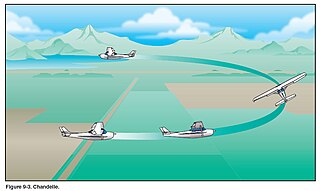 W
WThe chandelle is an aircraft control maneuver where the pilot combines a 180° turn with a climb.
 W
WAir combat maneuvering is the tactical art of moving, turning and/or situating one's fighter aircraft in order to attain a position from which an attack can be made on another aircraft. Air combat manoeuvres rely on offensive and defensive basic fighter manoeuvring (BFM) to gain an advantage over an aerial opponent.
 W
WA Cuban eight or Cuban 8 is a figure eight aerobatic maneuver for both full-scale and radio-controlled fixed-wing aircraft.
 W
WDelta Formation is a formation flying maneuvre in the shape of a V. It is used by the United States Air Force's Air Demonstration Squadron, the Thunderbirds. It is a famous formation of the Thunderbirds and is usually performed at the end of the show, when all the six aircraft come together.
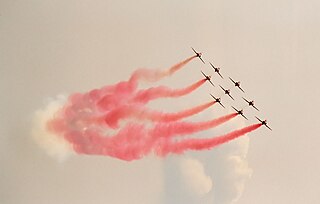 W
WA diamond formation is a formation of four or more aircraft, soldiers on horseback, players in a team sport, etc., wherein the elements of the group adopt a diamond, or kite, shape.
 W
WThe Dicta Boelcke is a list of fundamental aerial maneuvers of aerial combat formulated by First World War German flying ace, Oswald Boelcke. Equipped with one of the first fighter aircraft, Boelcke became Germany's foremost flying ace during 1915 and 1916. Because of his success in aerial combat and analytic mind, he was tasked by Colonel Hermann von der Lieth-Thomsen with writing a pamphlet on aerial tactics. Completed in June 1916, it was distributed throughout the German Army's Air Service (Die Fliegertruppen des Deutschen Kaiserreiches), some two years before the French and British militaries followed suit with their own tactical guides. Air combat tactical manuals based on the Dicta Boelcke have become more elaborate over time, and have become a mainstay for NATO's air combat training of American, German, Dutch, Norwegian, Turkish, Italian, and Greek fighter pilots.
 W
WA dogfight, or dog fight, is an aerial battle between fighter aircraft conducted at close range. Dogfighting first occurred in Mexico in 1913, shortly after the invention of the airplane. Until at least 1992, it was a component in every major war, despite beliefs after World War II that increasingly greater speeds and longer-range weapons would make dogfighting obsolete.
 W
WEights on Pylons or Pylon Eights, is a ground reference maneuver where an aircraft is flown in a figure eight pattern around two selected points on the ground. However, Eights on Pylons differs from similar maneuvers such as Eights Along a Road, Eights Across a Road, or Eights Around Pylons in that the objective of Eights on Pylons is not to maintain a specific altitude and ground track, but rather to fly the airplane so that the pylon remains fixed in place when viewed from the cockpit along a line parallel to the lateral axis of the aircraft. This is only possible when the aircraft is flown at the pivotal altitude corresponding to the current groundspeed. If the aircraft is flying in wind, the groundspeed will vary throughout the maneuver and thus the pivotal altitude will change also. However, the pivotal altitude varies only with the ground speed and not with the radius of turn or the angle of bank. So whether the maneuver is flown very close to the pylon with the aircraft banked 60 degrees, or farther from the pylon at 30 degrees bank, the necessary altitude is the same.
 W
WThe First School of Modern SkyFlying was founded in 1994 by the 'Father of FreeFly' Olav Zipser with the objective of researching, documenting, developing, teaching, training, and pushing the envelope of human flight capability, with an emphasis on Freeflying.
 W
WFreeflying is a skydiving discipline which began in the late 1980s, involving freefalling in various vertical orientations, as opposed to the traditional "belly-to-earth" orientation. The discipline is known to have originated when Olav Zipser began experimenting with non-traditional forms of bodyflight. Zipser founded the FreeFly Clowns as a two-person competitive team with Mike Vail in 1992, and was joined by Omar Alhegelan, Charles Bryan, and Stefania Martinengo in 1994. The FreeFly Clowns are also credited with opening the first school to teach freeflying, The First School of Modern SkyFlying.
 W
WHelocasting is an airborne technique used by small unit, special operations forces, also practiced extensively by the US Army's light infantry units, to insert into a military area of operations. The small unit is flown, by helicopter, to a maritime insertion point. Once there, the aircraft assumes an altitude just above the water's surface and an airspeed of 10 knots (19 km/h) or less. Team members then exit the aircraft and enter the water.
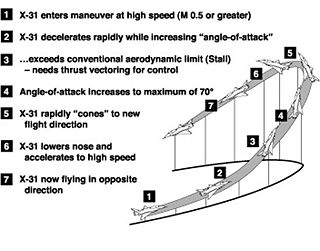 W
WThe Herbst maneuver is an air combat maneuver that uses post-stall technology such as thrust vectoring and advanced flight controls to achieve high angles of attack. The Herbst maneuver allows an aircraft to quickly reverse direction using a combination of high angle-of-attack and rolling. Though categorized with Pugachev's Cobra, which is popular at airshows, the Herbst maneuver is considered more useful in combat.
 W
WBasic fighter maneuvers (BFM) are tactical movements performed by fighter aircraft during air combat maneuvering, to gain a positional advantage over the opponent. BFM combines the fundamentals of aerodynamic flight and the geometry of pursuit, with the physics of managing the aircraft's energy-to-weight ratio, called its specific energy.
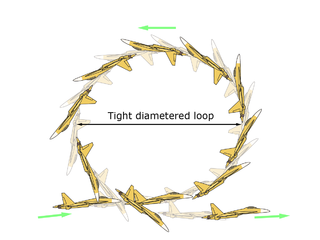 W
WThe "Kulbit" is an aerial maneuver developed by Russian pilots in which the aircraft performs an extremely tight loop, often not much wider than the length of the aircraft itself. It differs from the traditional inside loop as it uses post-stall maneuvering capabilities, a type of supermaneuverability. Like most post-stall maneuvers, it demonstrates pitch control outside the normal flight envelope wherein pitch control is made possible by having aerodynamic flow over the aircraft's elevators or stabilators.
 W
WLow flying military training involves military aircraft flying at low altitude to prepare their aircrew, and other military personnel, for nap-of-the-earth flying in wartime. The aircraft types can include advanced trainers, ground-attack aircraft, transports and helicopters.
 W
WNap-of-the-earth (NOE) is a type of very low-altitude flight course used by military aircraft to avoid enemy detection and attack in a high-threat environment.
 W
WBasic fighter maneuvers (BFM) are tactical movements performed by fighter aircraft during air combat maneuvering, to gain a positional advantage over the opponent. BFM combines the fundamentals of aerodynamic flight and the geometry of pursuit, with the physics of managing the aircraft's energy-to-weight ratio, called its specific energy.
 W
WA pylon turn is a flight maneuver in which an aircraft banks into a circular turn, in such a way that an imaginary line projecting straight out the side of the aircraft points to a fixed point on the ground. The maneuver originated early in the 20th century in air racing.
 W
WAerial refueling, also referred to as air refueling, in-flight refueling (IFR), air-to-air refueling (AAR), and tanking, is the process of transferring aviation fuel from one military aircraft to another during flight. The two main refueling systems are probe-and-drogue, which is simpler to adapt to existing aircraft, and the flying boom, which offers faster fuel transfer, but requires a dedicated boom operator station.
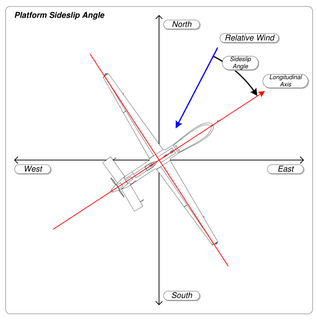 W
WA slip is an aerodynamic state where an aircraft is moving somewhat sideways as well as forward relative to the oncoming airflow or relative wind. In other words, for a conventional aircraft, the nose will be pointing in the opposite direction to the bank of the wing(s). The aircraft is not in coordinated flight and therefore is flying inefficiently.
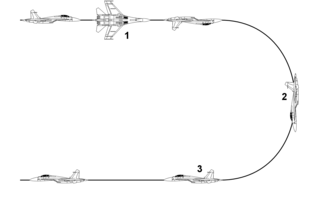 W
WThe Split S is an air combat maneuver mostly used to disengage from combat. To execute a Split S, the pilot half-rolls their aircraft inverted and executes a descending half-loop, resulting in level flight in the opposite direction at a lower altitude.
 W
WIn fluid dynamics, a stall is a reduction in the lift coefficient generated by a foil as angle of attack increases. This occurs when the critical angle of attack of the foil is exceeded. The critical angle of attack is typically about 15 degrees, but it may vary significantly depending on the fluid, foil, and Reynolds number.
 W
WA steep turn in aviation, performed by an aircraft, is a turn that involves a bank of more than 30 degrees. This means the angle created by the axis running along both wings and the horizon is more than 30 degrees. Generally, for training purposes, steep turns are demonstrated and practiced at 45 degrees, sometimes more. The purpose of learning and practicing a steep turn is to train a pilot to maintain control of an aircraft in cases of emergency such as structural damage, loss of power in one engine etc.
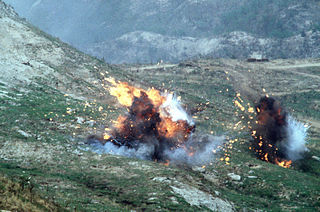 W
WTactical bombing is aerial bombing aimed at targets of immediate military value, such as combatants, military installations, or military equipment. This is in contrast to strategic bombing, or attacking enemy cities and factories to cripple future military production and enemy civilians' will to support the war effort, to debilitate the enemy's long-term capacity to wage war. A tactical bomber is a bomber aircraft with an intended primary role of tactical bombing, even though strategic bombers have been used in tactical bombing operations.
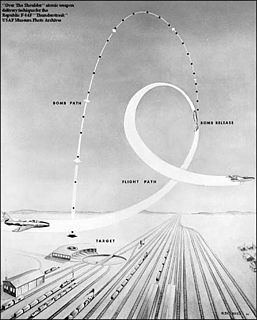 W
WToss bombing is a method of bombing where the attacking aircraft pulls upward when releasing its bomb load, giving the bomb additional time of flight by starting its ballistic path with an upward vector.
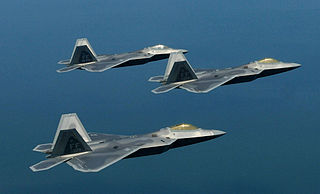 W
WThe Vic formation is a formation devised for military aircraft and first used during World War I. It comprises three or sometimes more aircraft flying in close formation with the leader at the apex and the rest of the flight en echelon to left and right, the whole resembling the letter "V". The name is derived from the term for the letter V in the phonetic alphabet of the time. It is still in use today, though it has been superseded or replaced in some circumstances.
 W
WWilde Sau was the term given by the Luftwaffe to the tactic used from 1943 to 1944 during World War II by which British night bombers were engaged by single-seat day-fighter aircraft flying in the Defence of the Reich.
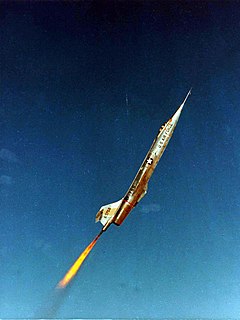 W
WA zoom climb is a climb where the rate of climb is greater than the maximum climb rate using only the thrust of the aircraft's engines. The additional climb rate is attained by reduction of horizontal speed. Before a zoom climb, the aircraft accelerates to a high air speed at an altitude at which it can operate in sustained level flight. The pilot then pulls steeply upward, trading the kinetic energy of forward motion for altitude. The aircraft gains potential energy (altitude) at the expense of kinetic energy. This is different from a steady climb, where the increase in potential energy comes from mechanical work done by the engines, rather than from the aircraft's kinetic energy.